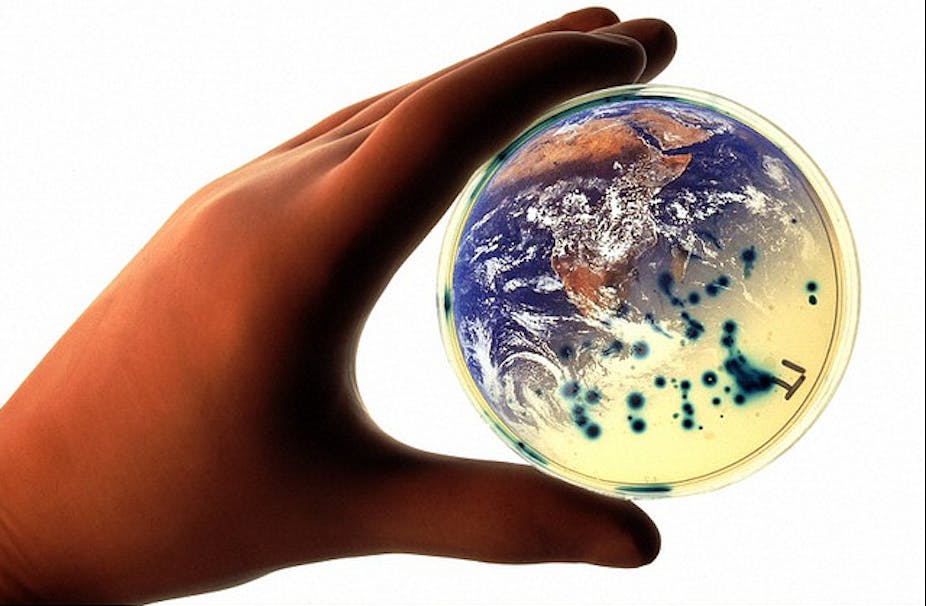With promises of improved medical treatments, greener energy and even artificial life, the field of synthetic biology has captured the public imagination and attracted significant government and commercial investment.
This excitement reached a crescendo on 21 May 2010, when scientists at the J Craig Venter Institute in the United States announced that they had made a “self-replicating synthetic bacterial cell”. This was the first living cell to have an entirely human-made genome, which means that all of the cell’s characteristics were controlled by a DNA sequence designed by scientists.
This achievement in biological engineering was made possible by combining molecular biotechnology, gene synthesis technology and information technology.
Possibilities of synthetic biology
In his autobiography, A Life Decoded, J. Craig Venter contends that synthetic biology has the potential to address concerns about energy security, climate change and sustainable development: “My company, Synthetic Genomics Inc., is already trying to turn an organism into a biofactory that could make clean hydrogen fuel from sunlight and water or soak up more carbon dioxide.”
He elaborated on his long-term scientific aspirations: “From there I want to take us far from shore into unknown waters, to a new phase of evolution, to the day when one DNA-based species can sit down at a computer to design another.”
Venter maintained: “I plan to show that we understand the software of life by creating true artificial life”.
Another leading researcher, Jay D. Keasling, is confident that the field of synthetic biology can increase access to essential medicines – particularly to provide protection against malaria.
However, civil society groups and technology activists have raised concerns about the risks synthetic biology may pose to security, public health and the environment. The ETC Group, for instance, is concerned that organisms made with synthetic biology (such as engineered bacteria) could be released into the environment, with unknown effects. They’re also concerned about potential weaponisation of synthetic biology.

Patentability
There has been much controversy over the application of patent law to emerging technologies, with large legal battles over the patentability of information technology and business methods, genetic testing, medical information, and stem cell research.
The field of synthetic biology also poses a number of challenges for patent law and public policy. One of the most important questions patent experts (such as Professor Graham Dutfield) are asking is whether synthetic biology is too different from previous biotechnologies to apply existing objections to the patenting of living things.
In addition to considering patentability of synthetic biology, patent offices and courts will have to consider the novelty, inventiveness and utility of the claimed inventions and scope of the claims, in light of the scientific knowledge in this field.
In the United States, patent applications for synthetic biology have fallen into two broad categories:
1) biological tools, methods and products.
2) computer programs. This includes software for design of biological devices and programs for analysis of biochemical activity within cells.
Some US patent applications have focused on the construction of a synthetic cell. Scientists at the J Craig Venter Institute, for example, have filed applications for patents on a minimal bacterial genome, a synthetic genome and a method of installing a genome into a cell.
Other US patent applications have involved the creation of useful biological products from cells, such as Jay D. Keasling and colleagues’ production of a malaria drug precursor in a genetically modified cell.
There are also patent applications for various methods of biofuel production.

Law reform
US President Barack Obama’s Presidential Commission for the Study of Bioethical Issues recommended that synthetic biology be regulated using the principles of public beneficence, responsible stewardship, intellectual freedom and responsibility, democratic deliberation and justice and fairness.
The Commission was, however, hopeful that synthetic biology could “be developed in an ethically responsible manner”.
But intellectual property expert Arti K. Rai has concerns that, as patent thickets have been a problem in the information technology and biotechnology sector, this could also slow the progress of synthetic biology research.
To counter this risk, some scientists and researchers have called for the introduction of a broad defence of experimental use, under patent law, to protect them from the threat of patent litigation.
The US-based group of scientists, BioBricks Foundation, already promotes open innovation in this field and have created a space to share their own research, right from the establishment of a new field.
Sharing of information and resources in synthetic biology research is facilitated by the Registry of Standard Biological Parts, which is supported by a culture of sharing in the synthetic biology community.
Somewhat more radically, biopunks – do-it-yourself biologists – question the use of intellectual property rights altogether in the field of synthetic biology. The international group of do-it-yourself biologists, known as DIYbio, has groups in North America, Europe and Asia, and individual members in many countries including Australia.
In his book, Biopunk, Marcus Wohlsen explains that in the US he’s observed, “An intellectual property system designed to spur innovation by allowing inventors to profit off their inventions has become in biopunks’ eyes a high-stakes game of low-stakes progress.”
The emerging field of synthetic biology is ripe for law review and reform, both overseas and at home in Australia. We’re seeing a proliferation of patents in this field, with the potential for significant impact on health, the environment and the economy.
If governments are serious about the progress of biological research, they will have to consider the implications of patenting and licensing of synthetic biology.
Matthew Rimmer and Alison McLennan are co-editors of Intellectual Property and Emerging Technologies: The New Biology (2012).

